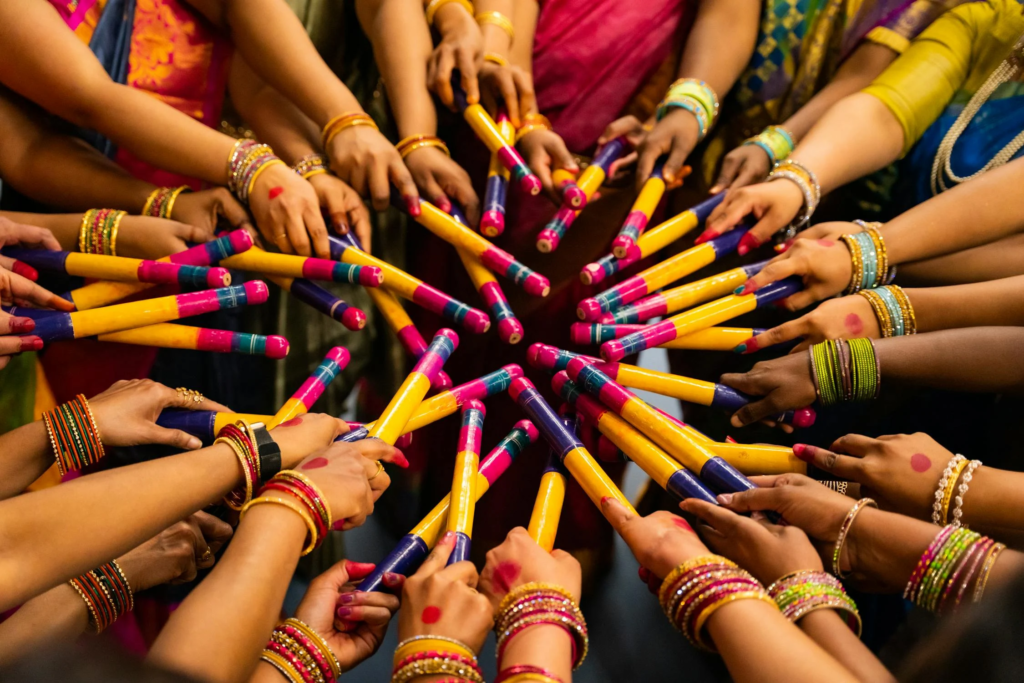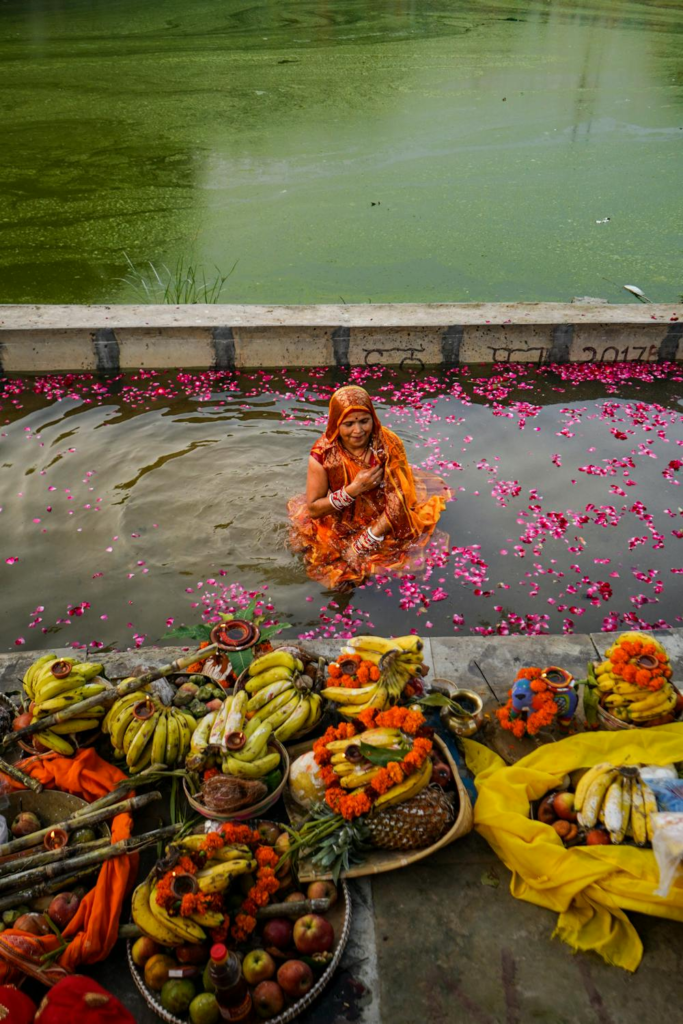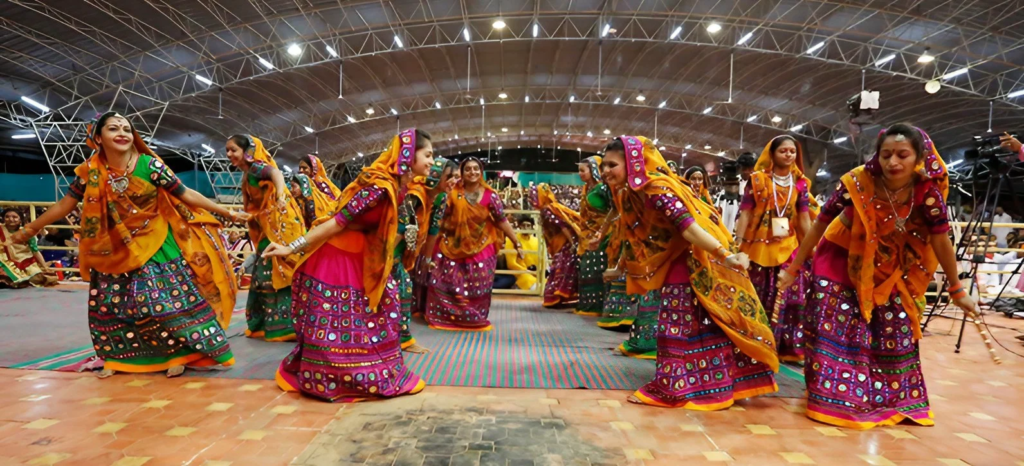Navratri is one of the most admired and revered Hindu festivals, dedicated to the worship of Goddess Durga in her nine powerful forms. Derived from the Sanskrit words “Nav” meaning nine and “Ratri” meaning night, the nine-night festival signifies the triumph of good over evil. Navratri is observed throughout India in colorful traditions, fasting, prayers, music, and dance. Being nine days long, each of them is associated with some different form of Goddess Durga and symbolized by a color, which makes this festival not only spiritually so beautiful but also aesthetically beautiful.

Navratri starts on 3rd October and ends on 11th October in 2024. Let us first know what those nine colors depict, what Navratri actually means, and how you can embrace the spirit of this fantastic festival.
What is Navratri? Understanding the Festival’s Significance
Navratri is much more than a religious festival; it marks time for reflection, cultural activities, and community functions. Traditionally, Navratri commemorates the triumph of Goddess Durga over the demon king Mahishasura, which had symbolized eternal domination of good over evil. People also use these days for renewal and purification by observing fasts and praying for bodily as well as spiritual well-being.
During the festival, temples are decorated with flowers and lights; homes are cleaned and decorated for welcoming the Goddess. Devotees of this season perform rituals and fast, thinking that these practices can bring them fortune, prosperity, and well-being. The nine nights can be divided into three parts. Goddess Durga is the epitome of power, so for the first three days, she is commemorated. Then, for the following three days, it is Lakshmi, the symbol of wealth. The last three days are dedicated to Saraswati, the embodiment of knowledge and wisdom.
Navratri 2024 Dates and Major Days
Here are the dates for Navratri 2024:
- Day 1 (October 3, 2024): Pratipada – Dedicated to Goddess Shailaputri
- Day 2 (October 4, 2024): Dwitiya – Dedicated to Goddess Brahmacharini
- Day 3 (October 5, 2024): Tritiya – Dedicated to Goddess Chandraghanta
- Day 4 (October 6, 2024): Chaturthi – Dedicated to Goddess Kushmanda
- Day 5 (October 7, 2024): Panchami – Dedicated to Goddess Skandamata
- Day 6 (October 8, 2024): Shashti – Dedicated to Goddess Katyayani
- October 9, 2024 (Day 7): Saptami – Dedicated to Goddess Kalaratri
- October 10, 2024 (Day 8): Ashtami – Dedicated to Goddess Mahagauri
- October 11, 2024 (Day 9): Navami – Dedicated to Goddess Siddhidatri
The last day of Navratri is celebrated as Vijayadashami or Dussehra, which denotes the last day of the nine nights and is further associated with victory of Lord Rama over Ravana and therefore, evil’s final win.
Nine Colours of Navratri 2024: What They Symbolize and How to Wear Them
Different colors of Navratri are attached to specific energies of the Goddess Durga and the form of the goddess that has to be worshiped on a particular day. This colorful progression is very commonly followed by devotees in their clothes, ornaments, and all other sorts of décor. Here’s a breakdown of the nine colors for Navratri 2024 and their meanings:
1. Day 1 (October 3, 2024) – Royal Blue: Power and Stability
Devotees worship Goddess Shailaputri on the first day, who is as much a daughter of mountains as she is nature and strength. This day is associated with the color Royal Blue, which represents power and stability. Wearing royal blue can invoke inner strength and peace.
- Introducing Yellow: Wear yellow sarees, kurtas, or lehengas. Decorate your home altar with yellow fabrics or flowers to resonate with the colors of the day.
2. Day 2 (4th October, 2024) – Yellow: Happiness and Energy
Goddess Brahmacharini is worshipped on the second day of Navratri. She embodies penance and true devotion. The color Yellow speaks of joy, enthusiasm, and energy. Let all positivity reign today and let happiness radiate out.
- Use Yellow: How to harness it – Wear those bright yellow clothes, don that set of yellow bangles, or adorn your living spaces with yellow marigolds to find reviving energy.
3. Day 3 (October 5, 2024) – Green: Growth and Prosperity
On this day, Goddess Chandraghanta is worshiped, who signifies beauty and bravery. Third day’s color is Green, signifying growth, prosperity, and new beginnings.
How to include Green:
Wear stylish green sarees, kurta sets, or even a dupatta. Fresh green potted plants or leaves can be added to your home decor.
4. Day 4 (October 6, 2024) – Grey: Balance and Neutrality
The fourth day of Sharad Navratri is devoted to the Goddess Kushmanda, who created the universe. The color Grey reflects balance and neutrality qualities that this form of goddess entails.
- Incorporation of Grey: Grey-toned clothes could be worn, or grey materials could be used in decoration at home. Grooming with Grey helps to achieve a grounded feeling and also provide a calm atmosphere to your festival celebrations.
5. Day 5 (October 7, 2024) – Orange: Energy and Enthusiasm
On the fifth day, all the devotees are expected to worship Goddess Skandamata, the mother of Lord Kartikeya. Orange symbolizes vibrancy, warmth, and enthusiasm, which are represented by the very qualities of this goddess’s personalities, her vibrant and life-giving nature.
- How to bring Orange: Some beautiful orange sarees, salwar kameez, and dupattas, orange gerberas or marigolds, can bring happiness in the surrounding atmosphere.
6. Day 6 (October 8, 2024) – White: Peace and Purity
The sixth day of Navratri is dedicated to Goddess Katyayani, the fierce warrior incarnation of Durga. The color White stands for purity, peace, and innocence. It’s a day to look for peace within yourself and clarity.
- How to incorporate White: Wear fresh white saree or kurta and also using white flowers or fabrics of your worship and pooja.
7. Day 7, October 9, 2024 Red Passion and Strength
On this day, the devotees worship Goddess Kalaratri, the destroyer of evil. The color Red is of strength, passion, boldness. It’s a powerful day to defy obstacles and to fight negativity.
- How to incorporate Red: Wear strong red clothes like a saree or lehenga, decorate with red flowers or candles in your decor, to make the energy level of the day more intense.
8. Day 8 (October 10, 2024) – Purple: Ambition and Power
Eighth day is called Ashtami. It is devoted to Mahagauri -Goddess of purity and calmness. The color of the eighth day is Purple -Ambition, power, or spirituality.
- How to include Purple: Wear clothes dyes colored with shades of purple. Decorate your home with flowers or candles to connect with the divine power of Goddess Mahagauri.
9. Day 9 (October 11, 2024) – Pink: Love and Compassion
The last day of Navratri, Navami, is dedicated to Goddess Siddhidatri, the bestower of supernatural powers. Pink symbolizes love, harmony, and compassion-the one who brings peace and unity.
- How to introduce Pink: Wear pink saris or lehengas, and you can add some pink flowers to decorate your prayer space while keeping in mind the soft and gentle character of the goddess.
How to Celebrate Navratri 2024: Traditions and Rituals
1. Fasting and Devotion

Fasting has emerged as the most significant aspect of Navratri rituals, and devotees abstain from grains, meat, and alcohol. Sweets, fruits, and dairy products, as well as gluten-free grains like buckwheat and amaranth, are eaten. Fasting is believed to purify the body and the mind and bring oneself closer to the divine.
2. Garba and Dandiya Raas

Navratri is also synonymous with Garba and Dandiya Raas, which are traditional dances to pay homage to the goddess. Multicoloured people gather and celebrate attired in colorful clothes before devotional songs as the energy and beauty of the goddess Durga come alive. Garba describes the cycle of life and Dandiya describes the battle between good and evil.
3. Durga Puja

While at Navratri, families and communities hold elaborate Durga Puja during which they pray for flowers.
Fruits and sweets to the goddess. The temples and homes are decorated with beauty, and there is the sound of devotional hymns filling the atmosphere. On Ashtami, young girls, referred to as Kanjak, are worshipped as representations of the goddess, and food and gifts are offered to them.
4. Vijayadashami or Dussehra

Navratri culminates with Vijayadashami or Dussehra, a day that is celebrated to win good over evil. In this day, effigies of Ravana are burnt everywhere in India symbolizing Lord Rama’s triumph over the demon king. It is a festive day marking the end of Navratri in glee and festivity.
Conclusion
Navratri 2024 promises to be a vibrant, colorful celebration filled with devotion, rituals, and cultural activities. It’s not only the addition of aesthetic value to the spiritual significance of the festival but also farther connects with the energies of Goddess Durga within the devoted followers through these nine sacred colors. Embracing these colors in your attire and surroundings would indeed express the essence of this joyful festival.
Be it fasting, puja, or just enjoyment through dance and music, Navratri forms a season of renewal, reflection, and celebration. So, embrace the colors, rituals, and energy that make this festival truly special on this Navratri.

